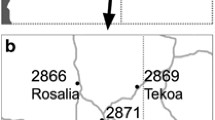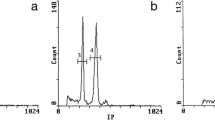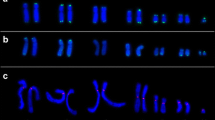Abstract
Tragopogon miscellus and Tragopogon mirus are two rare examples of allopolyploids that have formed recently in nature. Molecular cytogenetic studies have revealed chromosome copy number variation and intergenomic translocations in both allotetraploids. Due to a lack of interstitial chromosome markers, there remained the possibility of additional karyotype restructuring in these neopolyploids, via intrachromosomal and intragenomic rearrangements. To address this issue, we searched for additional high-copy tandem repeats in genomic sequences of the diploid progenitor species—Tragopogon dubius, Tragopogon pratensis and Tragopogon porrifolius—for application to the chromosomes of the allotetraploids. Eight novel repeats were localised by fluorescence in situ hybridisation (FISH) in the diploids; one of these repeats, TTR3, provided interstitial coverage. TTR3 was included in a cocktail with other previously characterised probes, producing better-resolved karyotypes for the three diploids. The cocktail was then used to test a hypothesis of karyotype restructuring in the recent allotetraploid T. miscellus by comparing repeat distributions to its diploid progenitors, T. dubius and T. pratensis. Five individuals of T. miscellus were selected from across the range of karyotypic variation previously observed in natural populations. FISH signal distributions mostly matched those observed in the diploid progenitors, with the exception of several losses or gains of signal at chromosomal subtermini and previously noted intergenomic translocations. Thus, in T. miscellus, we find most changes restricted to the subterminal regions, and although some were recurrent, none of the changes were common to all individuals analysed. We consider these findings in relation to the gene loss reported previously for T. miscellus.



Similar content being viewed by others
Abbreviations
- Cy3:
-
Cyanine 3
- Cy5:
-
Cyanine 5
- DAPI:
-
4′,6-Diamidino-2-phenylindole
- dsDNA:
-
Double-stranded deoxyribonucleic acid
- FISH:
-
Fluorescence in situ hybridisation
- GISH:
-
Genomic in situ hybridisation
- NGS:
-
Next-generation sequencing
- rDNA:
-
Ribosomal DNA
- TGP7:
-
Tragopogon porrifolius subtelomeric repeat-7
- TPRMBO:
-
Tragopogon pratensis tandemly repetitive sequence MboI-rich
- TR:
-
Tandem repeat
- TTR:
-
Tragopogon tandem repeat
References
Albert PS, Gao Z, Danilova TV, Birchler JA (2010) Diversity of chromosomal karyotypes in maize and its relatives. Cytogenet Genome Res 129:6–16
Anamthawat-Jonsson K, Heslop-Harrison JS (1993) Isolation and characterization of genome-specific DNA sequences in Triticeae species. Mol Gen Genet 240:151–158
Anamthawat-Jonsson K (2001) Molecular cytogenetics of introgressive hybridization in plants. Methods Cell Sci 23:139–148
Benson G (1999) Tandem repeats finder: a program to analyze DNA sequences. Nucleic Acids Res 27:573–580
Birchler JA, Albert SA, Gao Z (2008) Stability of repeated sequence clusters in hybrids of maize as revealed by FISH. Trop Plant Biol 1:34–39
Buggs RJA, Doust AN, Tate JA, Koh J, Soltis K, Feltus FA, Paterson AH, Soltis PS, Soltis DE (2009) Gene loss and silencing in Tragopogon miscellus (Asteraceae): comparison of natural and synthetic allotetraploids. Heredity 103:73–81
Buggs RJA, Chamala S, Wu W, Gao L, May GD, Schnable PS, Soltis DE, Soltis PS, Barbazuk WB (2010) Characterization of duplicate gene evolution in the recent natural allopolyploid Tragopogon miscellus by next-generation sequencing and Sequenom iPLEX MassARRAY genotyping. Mol Ecol 19:132–146
Buggs RJA, Chamala S, Wu W, Tate JA, Schnable PS, Soltis DE, Soltis PS, Barbazuk WB (2012a) Rapid, repeated, and clustered loss of duplicate genes in allopolyploid plant populations of independent origin. Curr Biol 22:248–252
Buggs RJA, Renny-Byfield S, Chester M, Jordon-Thaden IE, Viccini LF, Chamala S, Leitch AR, Schnable PS, Barbazuk WB, Soltis PS, Soltis DE (2012b) Next-generation sequencing and genome evolution in allopolyploids. Am J Bot 99:372–382
Chester M, Gallagher JP, Symonds VV, da Silva AVC, Mavrodiev EV, Leitch AR, Soltis PS, Soltis DE (2012) Extensive chromosomal variation in a recently formed natural allopolyploid species, Tragopogon miscellus (Asteraceae). P Natl Acad Sci USA 109:1176–1181
Doyle J, Doyle J (1987) A rapid DNA isolation procedure for small quantities of fresh leaf tissue. Phytochem Bull 19:11–15
Forsström PO, Merker A, Schwarzacher T (2002) Characterisation of mildew resistant wheat-rye substitution lines and identification of an inverted chromosome by fluorescent in situ hybridisation. Heredity 88:349–355
Gonzalez-Garcia M, Cuacos M, Gonzalez-Sanchez M, Puertas MJ, Vega JM (2011) Painting the rye genome with genome-specific sequences. Genome 54:555–564
Hřibová E, Neumann P, Matsumoto T, Roux N, Macas J, Doležel J (2010) Repetitive part of the banana (Musa acuminata) genome investigated by low-depth 454 sequencing. BMC Plant Biol 10:204
Kato A, Lamb JC, Birchler JA (2004) Chromosome painting using repetitive DNA sequences as probes for somatic chromosome identification in maize. P Natl Acad Sci USA 101:13554–13559
Kato A, Lamb JC, Albert PS, Danilova T, Han F, Gao Z, Findley S, Birchler JA (2011) Chromosome painting for plant biotechnology. In: Birchler JA (ed) Plant chromosome engineering: methods and protocols, methods in molecular biology. Humana, New York
Kibbe WA (2007) OligoCalc: an online oligonucleotide properties calculator. Nucleic Acids Res 35:W43–W46
Lamb JC, Birchler JA (2006) Retroelement genome painting: cytological visualization of retroelement expansions in the genera Zea and Tripsacum. Genetics 173:1007–1021
Lim KY, Soltis DE, Soltis PS, Tate J, Matyasek R, Srubarova H, Kovarik A, Pires JC, Xiong ZY, Leitch AR (2008) Rapid chromosome evolution in recently formed polyploids in Tragopogon (Asteraceae). PLoS One 3:e3353
Macas J, Neumann P, Navratilova A (2007) Repetitive DNA in the pea (Pisum sativum L.) genome: comprehensive characterization using 454 sequencing and comparison to soybean and Medicago truncatula. Bmc Genomics 8:427
Macas J, Kejnovský E, Neumann P, Novák P, Koblizkova A, Vyskot B (2011) Next generation sequencing-based analysis of repetitive DNA in the model dioceous plant Silene latifolia. PLoS One 6:e27335
Malinska H, Tate JA, Matyasek R, Leitch AR, Soltis DE, Soltis PS, Kovarik A (2010) Similar patterns of rDNA evolution in synthetic and recently formed natural populations of Tragopogon (Asteraceae) allotetraploids. BMC Evol Biol 10:291
Malinska H, Tate JA, Mavrodiev E, Matyasek R, Lim KY, Leitch AR, Soltis DE, Soltis PS, Kovarik A (2011) Ribosomal RNA genes evolution in Tragopogon: a story of new and old world allotetraploids and the synthetic lines. Taxon 60:348–354
Margulies M, Egholm M, Altman WE, Attiya S, Bader JS, Bemben LA, Berka J, Braverman MS, Chen YJ, Chen ZT, Dewell SB, Du L, Fierro JM, Gomes XV, Godwin BC, He W, Helgesen S, Ho CH, Irzyk GP, Jando SC, Alenquer MLI, Jarvie TP, Jirage KB, Kim JB, Knight JR, Lanza JR, Leamon JH, Lefkowitz SM, Lei M, Li J, Lohman KL, Lu H, Makhijani VB, McDade KE, McKenna MP, Myers EW, Nickerson E, Nobile JR, Plant R, Puc BP, Ronan MT, Roth GT, Sarkis GJ, Simons JF, Simpson JW, Srinivasan M, Tartaro KR, Tomasz A, Vogt KA, Volkmer GA, Wang SH, Wang Y, Weiner MP, Yu PG, Begley RF, Rothberg JM (2005) Genome sequencing in microfabricated high-density picolitre reactors. Nature 437:376–380
Mavrodiev EV, Tancig M, Sherwood AM, Gitzendanner MA, Rocca J, Soltis PS, Soltis DE (2005) Phylogeny of Tragopogon L. (Asteraceae) based on internal and external transcribed spacer sequence data. Int J Plant Sci 166:117–133
Mavrodiev EV, Soltis PS, Gitzendanner MA, Baldini RM, Soltis DE (2007) Polyphyly of Tragopogon porrifolius L. (Asteraceae), a European native with intercontinental disjuncts. Int J Plant Sci 168:889–904
Mavrodiev EV, Soltis PS, Soltis DE (2008) Putative parentage of six old world polyploids in Tragopogon L. (Asteraceae: Scorzonerinae) based on ITS, ETS, and plastid sequence data. Taxon 57:1215–1232
Novak P, Neumann P, Macas J (2010) Graph-based clustering and characterization of repetitive sequences in next-generation sequencing data. BMC Bioinformatics 11:378
Ownbey M (1950) Natural hybridization and amphiploidy in the genus Tragopogon. Am J Bot 37:487–499
Ownbey M, McCollum G (1954) The chromosomes of Tragopogon. Rhodora 56:7–21
Pires JC, Lim KY, Kovarik A, Matyasek R, Boyd A, Leitch AR, Leitch IJ, Bennett MD, Soltis PS, Soltis DE (2004) Molecular cytogenetic analysis of recently evolved Tragopogon (Asteraceae) allopolyploids reveal a karyotype that is additive of the diploid progenitors. Am J Bot 91:1022–1035
Renny-Byfield S, Kovařík A, Chester M, Nichols RA, Macas J, Novák P, Leitch AR (2012) Independent, rapid and targeted loss of highly repetitive DNA in natural and synthetic allopolyploids of Nicotiana tabacum. PLoS One 7:e36963
Sobreira TJP, Durham AM, Gruber A (2006) TRAP: automated classification, quantification and annotation of tandemly repeated sequences. Bioinformatics 22:361–362
Soltis DE, Soltis PS, Pires JC, Kovarik A, Tate JA, Mavrodiev E (2004) Recent and recurrent polyploidy in Tragopogon (Asteraceae): cytogenetic, genomic and genetic comparisons. Biol J Linn Soc 82:485–501
Stajich JE, Block D, Boulez K, Brenner SE, Chervitz SA, Dagdigian C, Fuellen G, Gilbert JGR, Korf I, Lapp H, Lehvaslaiho H, Matsalla C, Mungall CJ, Osborne BI, Pocock MR, Schattner P, Senger M, Stein LD, Stupka E, Wilkinson MD, Birney E (2002) The Bioperl toolkit: perl modules for the life sciences. Genome Res 12:1611–1618
Swaminathan K, Varala K, Hudson ME (2007) Global repeat discovery and estimation of genomic copy number in a large, complex genome using a high-throughput 454 sequence survey. BMC Genomics 8:132
Szadkowski E, Eber F, Huteau V, Lode M, Huneau C, Belcram H, Coriton O, Manzanares-Dauleux MJ, Delourme R, King GJ, Chalhoub B, Jenczewski E, Chevre AM (2010) The first meiosis of resynthesized Brassica napus, a genome blender. New Phytol 186:102–112
Tate JA, Ni ZF, Scheen AC, Koh J, Gilbert CA, Lefkowitz D, Chen ZJ, Soltis PS, Soltis DE (2006) Evolution and expression of homeologous loci in Tragopogon miscellus (Asteraceae), a recent and reciprocally formed allopolyploid. Genetics 173:1599–1611
Tate JA, Joshi P, Soltis KA, Soltis PS, Soltis DE (2009) On the road to diploidization? Homoeolog loss in independently formed populations of the allopolyploid Tragopogon miscellus (Asteraceae). BMC Plant Biol 9:80
Wilson FD (1983) Karyotypes of Tragopogon (Compositae: Lactuceae). Brittonia 35:341–350
Xiong ZY, Pires JC (2011) Karyotype and identification of all homoeologous chromosomes of allopolyploid Brassica napus and its diploid progenitors. Genetics 187:37–49
Zhang P, Li W, Friebe B, Gill BS (2004) Simultaneous painting of three genomes in hexaploid wheat by BAC-FISH. Genome 47:979–987
Acknowledgments
We thank Matt Gitzendanner for bioinformatics support. This work was supported by National Science Foundation Grants DEB-0922003 and DEB-1146065.
Author information
Authors and Affiliations
Corresponding author
Additional information
Responsible Editor: Jiming Jiang.
Electronic supplementary material
Below is the link to the electronic supplementary material.
Fig. S1
Bar chart showing the percentage abundance of the 40 most common tandem repeats. (JPEG 16 kb)
High resolution image
(TIFF 563 kb)
Fig. S2
FISH applied to mitotic chromosomes of T. dubius, T. porrifolius and T. pratensis with probes to a dub198; b pra001; c TTR4; d TTR6; e 5S rDNA. In c, arrows indicate hybridisation to minor 35S rDNA sites, on the short arm of chromosome D Po. Scale bar 5 μm. (JPEG 43 kb)
High resolution image
(TIFF 634 kb)
Fig. S3
FISH reprobing with 5S rDNA probe (magenta) merged with the same metaphase chromosomes as shown in Fig. 2d of T. porrifolius. Arrows indicate 5S rDNA array positions. Scale bar 5 μm. (JPEG 5 kb)
High resolution image
(TIFF 139 kb)
Table S1
Repeat monomer consensus sequences (DOC 62 kb)
Table S2
PCR primer sequences and cloned probe sequences (DOC 32 kb)
Table S3
Complementary oligonucleotide probe template sequences (DOC 46 kb)
Rights and permissions
About this article
Cite this article
Chester, M., Lipman, M.J., Gallagher, J.P. et al. An assessment of karyotype restructuring in the neoallotetraploid Tragopogon miscellus (Asteraceae). Chromosome Res 21, 75–85 (2013). https://doi.org/10.1007/s10577-013-9339-y
Received:
Revised:
Accepted:
Published:
Issue Date:
DOI: https://doi.org/10.1007/s10577-013-9339-y




